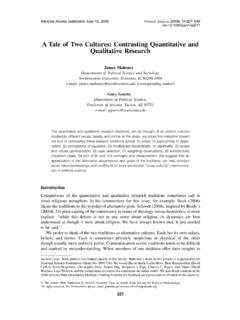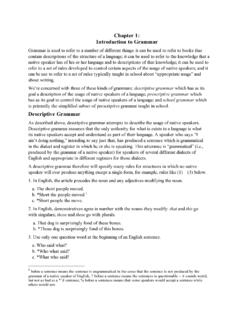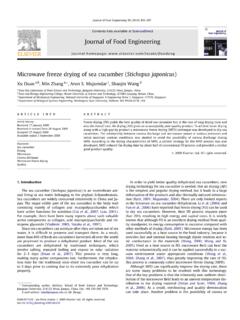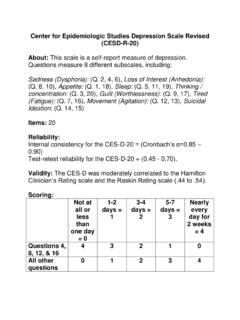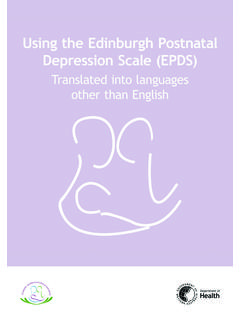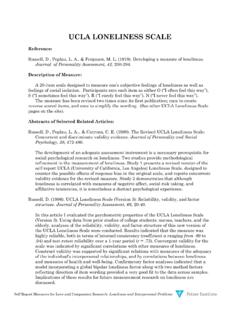Transcription of What Are the Benefits of Plants Indoors and Why Do We ...
1 Author s draft, page Final publication availabe from: : Lohr, 2010. What are the Benefits of Plants Indoors and why do we respond positively to them? Acta Horticulturae 881(2):675-682. 1 What Are the Benefits of Plants Indoors and Why Do We Respond Positively to Them? Virginia I. Lohr Department of Horticulture and Landscape Architecture Washington State University Pullman, WA 99164-6414, USA Keywords: foliage Plants , human issues in horticulture, human well-being, interior Plants , people-plant interaction, response to nature Abstract Plants are essential for our survival. They provide food, fiber, building material, fuel, and pharmaceuticals. Plants also produce intangible Benefits for people, such as improving our health. These Benefits occur with Plants outdoors and Indoors .
2 People have been bringing Plants into their homes for thousands of years. We increasingly work Indoors , and we are making ample use of Plants in these spaces as well. Plants Indoors have many Benefits . Physically, they contribute to cleaner, healthier air for us to breathe, thus improving our well-being and comfort. They make our surroundings more pleasant, and they make us feel calmer. Interior Plants have been associated with reduced stress, increased pain tolerance, and improved productivity in people. Research studies documenting some of the Benefits associated with interior Plants are discussed. Of increasing interest to many people is the question of why Plants have intangible positive effects on us. If we understand this, then we can make better recommendations regarding the use of Plants Indoors and out to enhance their effects of people.
3 studies indicate that people have learned and innate responses to Plants . Some of these responses appear to have genetic components. Specific studies are summarized, and potential applications of the results of these studies are presented. INTRODUCTION Plants are essential for life as we know it. They provide food, fiber, building material, fuel, and pharmaceuticals. Plants also decorate our homes, both inside and out, and mark special occasions, such as weddings and funerals. For thousands of years, people around the world have grown Plants in containers and brought them into their living spaces. For thousands of years, Plants and gardening have also been considered good for people, physically, mentally, and socially, yet until recently, information about the intangible effects of Plants on people were based on case studies , such as people saying working in their gardens made them feel better.
4 Today there are numerous scientific studies documenting the relationships between people and Plants , both Indoors and out (for summaries, see: Lohr, 2000; Pearson-Mims and Lohr, 2000; Relf and Lohr, 2003). The range of Benefits that has been documented is broad: air quality is improved (Wood et al., 2002), stress is lowered (Dijkstra et al., 2008), recovery from illness is faster (Ulrich, 1984), mental fatigue is reduced (Tennessen and Cimprich, 1995), and productivity is higher (Lohr et al., 1996). studies on the Benefits of Plants are contributing to an increased use of Plants to solve both environmental and health problems. The physical cause of the tangible effects, such as removing air pollutants, are relatively well understood.
5 The basis for the intangible effects, such as increased happiness, is not well-understood. A lack of understanding of the theoretical basis hinders the most effective use of Plants to deal with these issues. This paper examines some of the studies that have documented the beneficial effects of Plants , focusing on those used Indoors , and then examines some of the postulated reasons why humans respond positively to Plants . Author s draft, page Final publication availabe from: : Lohr, 2010. What are the Benefits of Plants Indoors and why do we respond positively to them? Acta Horticulturae 881(2):675-682. 2 Benefits OF INTERIOR Plants Indoor Air Quality One of the ways Plants affect people is through the physical changes that Plants cause to their surroundings.
6 For example, Plants release oxygen and moisture into the air. Some of these changes to the environment can increase the health and comfort level for humans in enclosed environments. Interior Plants are now playing a role in phyto-remediation, and significant work has been done in this area. 1. Air Pollutants. The National Aeronautics and Space Administration funded early studies on using Plants to clean the air in space stations. The studies showed that many common foliage Plants reduced levels of some interior pollutants, including formaldehyde and carbon monoxide, from small, sealed test chambers (Wolverton et al., 1984; 1985). The pollution reduction was largely due to bacteria growing on the plant roots (Wolverton et al.)
7 , 1989; Wood et al., 2002). Further research has shown that Plants remove many indoor air pollutants, including ozone, toluene, and benzene (Darlington et al., 2001; Wood et al., 2002; Papinchak et al., 2009). When this research first received wide publicity, many in the building industry dismissed the work, because it was done in small controlled chambers. Recent studies have shown that the effect does scale up to the whole building level (Burchett et al., 2005). Based on such findings, Darlington et al. (2001) developed a biofiltration unit with interior Plants and an aquarium that can effectively maintain healthy indoor air. 2. Relative Humidity. Other studies on the impacts of Plants on air quality, and thus indirectly on human health, have followed.
8 One study documented that foliage Plants can raise relative humidity to healthier and more comfortable levels in interior spaces (Lohr, 1992). The relative humidity of the air inside buildings is often below the range of 30% to 60% recommended for human comfort, especially when buildings are being heated. When the indoor relative humidity is too low, colds are more frequent and wood dries and cracks. In this study, when Plants were present, less than 2% of the space was occupied by the Plants , yet relative humidity was raised from 25% without Plants to 30% with Plants . Some people have been concerned that interior Plants might increase relative humidity too much, but this is unlikely to occur: when the relative humidity rises, the rate of water loss from the plant slows, because water does not evaporate as rapidly when humidity is high.
9 3. Particulate Matter. The influence of interior Plants on dust accumulation has also been explored (Lohr and Pearson-Mims, 1996). Adding Plants to the periphery of a room reduced particulate matter deposition by as much as 20%, even in center of the room many meters from the Plants . The Plants were in self-watering containers that watered the Plants from below, and the growing medium surface was extremely dry and dusty. Documenting that under such circumstance interior Plants were associated with reduced dust was especially important, because it allayed fears that the growing medium in containers might actually be making interiors dustier. 4. Acoustics. A study conducted by Costa and Lothian examined the effects of interior Plants on acoustics in interior spaces (Freeman, 2003).
10 This study found, as is common in studies of acoustics, that the effects were complex. They showed that Plants can reflect, diffract, or absorb sounds, depending on the frequency. Plants were shown to reduce noise under certain conditions. The response was affected by many variables, including sound frequency, plant placement, and the specific room. Generally, the researchers found that Plants worked best at reducing high frequencies sounds in rooms with hard surfaces; the effect was similar to adding carpet. Well-being 1. Feelings. Many studies asking people how they feel in the presence or absence of Plants have revealed a number of positive feelings associated with Plants . In a study of Author s draft, page Final publication availabe from: : Lohr, 2010.


